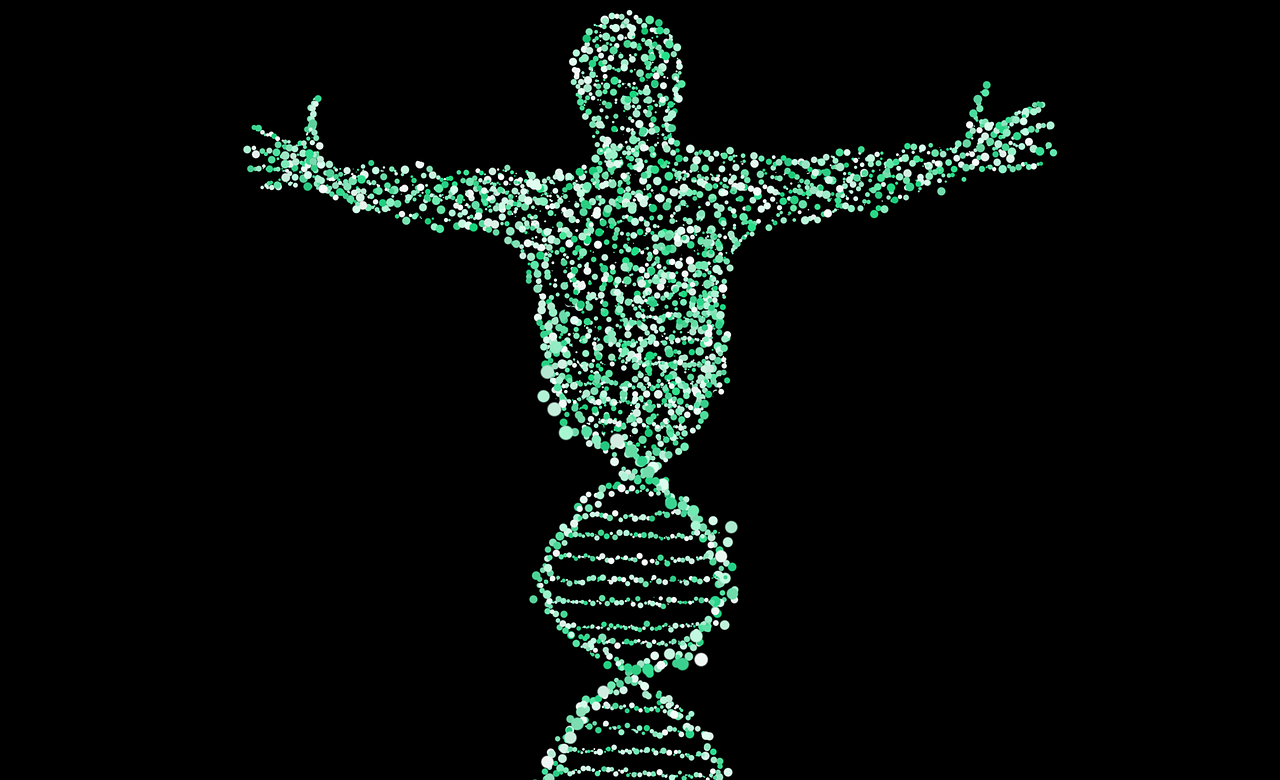Cataloging every genetic disorder with detailed information is a monumental task, as over 10,000 genetic disorders have been identified in humans alone, with thousands more in animals. Many are rare, poorly understood, or lack comprehensive documentation.
So What is Genetics?
Genetics is the branch of biology that studies genes, heredity, and genetic variation in living organisms. It explains how traits are passed from parents to offspring and how genetic mutations can lead to diseases.
Key Concepts in Genetics:
Mutation: A change in DNA sequence that can cause disease. Providing exhaustive details for each would exceed practical response limits and result in an overwhelming volume of information. Instead, I will provide a structured overview of the major categories of genetic disorders, highlight key examples within each category with detailed explanations, and include a representative list of disorders. For animals, I’ll summarize common genetic disorders with examples. This approach balances comprehensiveness with clarity.
DNA (Deoxyribonucleic Acid): The molecule that carries genetic instructions.
Gene: A segment of DNA that codes for a specific protein or function.
Chromosome: A packaged structure of DNA (humans have 23 pairs).
Genome: The complete set of genetic material in an organism.
How Do Genetic Diseases Occur?
Genetic disorders are caused by abnormalities in DNA, ranging from single-gene mutations to chromosomal anomalies. They can be inherited or arise spontaneously and affect humans and animals. Below is a detailed overview of the main categories, key examples with in-depth information, and a broader list of disorders.
Genetic diseases occur due to mutations in DNA that disrupt normal biological functions. These mutations can be:
- Inherited (passed from parents to children)
- Acquired (caused by environmental factors like radiation or chemicals)
Mechanisms of Genetic Diseases:
| Type of Mutation | Effect | Example Disease |
|---|---|---|
| Single-Gene (Mendelian) | Mutation in one gene | Cystic Fibrosis, Sickle Cell Anemia |
| Chromosomal Abnormalities | Extra/missing chromosomes | Down Syndrome (Trisomy 21) |
| Multifactorial Disorders | Genes + environment | Heart Disease, Diabetes |
| Mitochondrial Mutations | Defects in mitochondrial DNA | Leber’s Hereditary Optic Neuropathy |
1. Single-Gene Disorders
These result from mutations in a single gene, following Mendelian inheritance patterns (autosomal dominant, autosomal recessive, or X-linked). Approximately 7,000 single-gene disorders are known in humans.
Key Examples
Cystic Fibrosis (Autosomal Recessive)
- Cause: Mutations in the CFTR gene (most common: ΔF508 deletion) on chromosome 7, impairing chloride ion transport.
- Symptoms: Chronic lung infections, pancreatic insufficiency, salty sweat, infertility in males.
- Prevalence: ~1 in 2,500 newborns (higher in Caucasian populations).
- Diagnosis: Sweat chloride test, genetic testing.
- Treatment:
- CFTR modulators (e.g., ivacaftor, lumacaftor) for specific mutations.
- Airway clearance therapies, antibiotics, pancreatic enzyme supplements.
- Prognosis: Median life expectancy ~50 years with modern treatments.
- Research: Gene therapy trials and CRISPR-based correction of CFTR mutations.
Huntington’s Disease (Autosomal Dominant)
- Cause: CAG trinucleotide repeat expansion in the HTT gene on chromosome 4, leading to toxic huntingtin protein accumulation.
- Symptoms: Progressive motor dysfunction (chorea), cognitive decline, psychiatric issues (e.g., depression).
- Prevalence: ~1 in 10,000–20,000 globally.
- Diagnosis: Genetic testing for CAG repeats (>36 repeats confirm diagnosis).
- Treatment: Symptomatic (e.g., tetrabenazine for chorea, antipsychotics). No cure.
- Prognosis: Fatal 10–20 years after symptom onset.
- Research: RNA-based therapies (e.g., antisense oligonucleotides) and gene silencing.
Hemophilia A (X-Linked Recessive)
- Cause: Mutations in the F8 gene on the X chromosome, reducing functional factor VIII (blood clotting protein).
- Symptoms: Severe bleeding (joints, muscles), easy bruising, prolonged bleeding after injury.
- Prevalence: ~1 in 5,000 male births.
- Diagnosis: Coagulation tests, genetic testing.
- Treatment:
- Factor VIII replacement therapy (infusions).
- Gene therapy (e.g., valoctocogene roxaparvovec).
- Prognosis: Manageable with treatment; risk of joint damage or fatal bleeds without care.
- Research: Long-acting factor VIII products, CRISPR trials.
Other Single-Gene Disorders
- Sickle Cell Anemia: Beta-globin gene mutation; causes deformed red blood cells, anemia, pain crises.
- Tay-Sachs Disease: HEXA gene mutation; leads to neurodegeneration, fatal by early childhood.
- Phenylketonuria (PKU): PAH gene mutation; impairs phenylalanine metabolism, treatable with diet.
- Duchenne Muscular Dystrophy: DMD gene mutation; progressive muscle degeneration.
- Marfan Syndrome: FBN1 gene mutation; affects connective tissue, causing heart and skeletal issues.
- Fragile X Syndrome: FMR1 gene mutation; intellectual disability, autism-like features.
2. Chromosomal Disorders
These involve structural or numerical abnormalities in chromosomes, often detected via karyotyping.
Key Examples
Down Syndrome (Trisomy 21)
- Cause: Extra copy of chromosome 21 (95% due to nondisjunction during meiosis).
- Symptoms: Intellectual disability, characteristic facial features (e.g., upslanting eyes), heart defects, hypotonia.
- Prevalence: ~1 in 700 births (increases with maternal age).
- Diagnosis: Prenatal screening (e.g., ultrasound, cell-free DNA), confirmed by karyotyping.
- Treatment: Early intervention (speech, physical therapy), surgical correction of heart defects.
- Prognosis: Life expectancy ~60 years; quality of life varies.
- Research: Studies on cognitive enhancement drugs, gene silencing of extra chromosome.
Turner Syndrome (Monosomy X)
- Cause: Missing or partial X chromosome in females (45,X karyotype).
- Symptoms: Short stature, infertility, heart anomalies, webbed neck.
- Prevalence: ~1 in 2,500 female births.
- Diagnosis: Karyotyping, often prenatal or at puberty.
- Treatment: Growth hormone, estrogen replacement for puberty.
- Prognosis: Normal life expectancy with management; infertility common.
- Research: Fertility preservation techniques (e.g., oocyte cryopreservation).
Klinefelter Syndrome (XXY)
- Cause: Extra X chromosome in males (47,XXY).
- Symptoms: Hypogonadism, tall stature, learning difficulties, infertility.
- Prevalence: ~1 in 500–1,000 males.
- Diagnosis: Karyotyping, often at puberty or during infertility evaluation.
- Treatment: Testosterone therapy, educational support.
- Prognosis: Near-normal life expectancy; fertility possible with assisted reproduction.
- Research: Improving fertility outcomes via testicular sperm extraction.
Other Chromosomal Disorders
- Trisomy 18 (Edwards Syndrome): Severe developmental delays, often fatal in infancy.
- Trisomy 13 (Patau Syndrome): Cleft lip/palate, heart defects, early mortality.
- Cri-du-Chat Syndrome: Deletion on 5p; high-pitched cry, intellectual disability.
- Wolf-Hirschhorn Syndrome: Deletion on 4p; growth retardation, seizures.
3. Multifactorial Disorders
These result from multiple genetic variants interacting with environmental factors.
Key Examples
Coronary Artery Disease
- Cause: Polygenic risk (e.g., variants in LDLR, APOE) plus lifestyle factors (diet, smoking).
- Symptoms: Chest pain, heart attack, heart failure.
- Prevalence: Leading cause of death globally (~9 million deaths annually).
- Diagnosis: ECG, stress tests, genetic risk scores.
- Treatment: Statins, lifestyle changes, surgical interventions (e.g., stents).
- Research: Polygenic risk scores for early prevention, novel lipid-lowering drugs.
Type 2 Diabetes
- Cause: Variants in TCF7L2, PPARG, combined with obesity, sedentary lifestyle.
- Symptoms: High blood sugar, fatigue, kidney/eye complications.
- Prevalence: ~537 million adults globally (2021 estimate).
- Diagnosis: Blood glucose tests, HbA1c.
- Treatment: Metformin, insulin, diet/exercise.
- Research: Gene-environment interaction studies, beta-cell regeneration.
Breast Cancer (BRCA1/2 Mutations)
- Cause: High-penetrance mutations in BRCA1/BRCA2, plus environmental triggers.
- Symptoms: Breast lumps, changes in breast shape, metastasis.
- Prevalence: ~1 in 8 women (lifetime risk); 5–10% hereditary.
- Diagnosis: Mammography, genetic testing.
- Treatment: Surgery, chemotherapy, PARP inhibitors for BRCA mutations.
- Research: Preventive gene therapies, improved screening algorithms.
Other Multifactorial Disorders
- Hypertension: Genetic variants (e.g., AGT) plus diet, stress.
- Alzheimer’s Disease: APOE4 variant, aging, environmental factors.
- Asthma: Multiple genes, allergens, pollution.
- Rheumatoid Arthritis: HLA genes, immune triggers.
4. Mitochondrial Disorders
These arise from mutations in mitochondrial DNA (maternally inherited) or nuclear genes affecting mitochondria.
Key Examples
MELAS Syndrome
- Cause: Mutations in MT-TL1 or other mitochondrial genes, impairing energy production.
- Symptoms: Stroke-like episodes, muscle weakness, lactic acidosis, seizures.
- Prevalence: Rare (~1 in 4,000).
- Diagnosis: Muscle biopsy, genetic testing.
- Treatment: Symptomatic (e.g., coenzyme Q10, anticonvulsants).
- Prognosis: Progressive; varies by mutation severity.
- Research: Mitochondrial replacement therapy, antioxidant therapies.
Leber’s Hereditary Optic Neuropathy (LHON)
- Cause: Mutations in MT-ND1, MT-ND4, or MT-ND6 genes, affecting optic nerve.
- Symptoms: Rapid vision loss, usually in young adults.
- Prevalence: ~1 in 30,000–50,000.
- Diagnosis: Genetic testing, ophthalmologic exams.
- Treatment: Idebenone (antioxidant), supportive care.
- Prognosis: Permanent vision loss; some spontaneous recovery.
- Research: Gene therapy targeting optic nerve rescue.
Other Mitochondrial Disorders
- MERRF Syndrome: Myoclonic epilepsy, ragged-red fibers in muscles.
- Kearns-Sayre Syndrome: Eye muscle paralysis, heart block, pigmentary retinopathy.
- Leigh Syndrome: Neurodegeneration, developmental regression.
5. Genetic Disorders in Animals
Animal genetic disorders are less cataloged but critical in veterinary medicine, agriculture, and conservation.
Key Examples
Canine Hip Dysplasia (Dogs)
- Cause: Polygenic, involving multiple genes (e.g., those affecting joint development), plus environmental factors (e.g., rapid growth).
- Symptoms: Lameness, arthritis, difficulty moving.
- Prevalence: Common in large breeds (e.g., German Shepherds, Labradors).
- Diagnosis: X-rays, genetic screening.
- Treatment: Weight management, anti-inflammatory drugs, surgery (e.g., hip replacement).
- Research: Genomic selection to reduce prevalence.
Polycystic Kidney Disease (Cats)
- Cause: Mutation in PKD1 gene (autosomal dominant).
- Symptoms: Kidney cysts, renal failure, hypertension.
- Prevalence: ~38% in Persian cats.
- Diagnosis: Ultrasound, genetic testing.
- Treatment: Supportive (e.g., fluid therapy, diet); no cure.
- Research: Gene editing for prevention.
Bovine Leukocyte Adhesion Deficiency (BLAD) (Cattle)
- Cause: Mutation in ITGB2 gene (autosomal recessive).
- Symptoms: Recurrent infections, poor growth, early death.
- Prevalence: Rare; historically significant in Holsteins.
- Diagnosis: Genetic testing.
- Treatment: None; affected animals culled.
- Research: Eradication via selective breeding.
Other Animal Disorders
- Progressive Retinal Atrophy (Dogs): Gene mutations (e.g., PRCD); leads to blindness.
- Hereditary Equine Regional Dermal Asthenia (Horses): PPIB mutation; fragile skin.
- Porcine Stress Syndrome (Pigs): RYR1 mutation; stress-induced sudden death.
- Inbreeding-Related Defects (Wild Animals): Reduced fertility, congenital anomalies in endangered species (e.g., cheetahs).
Comprehensive List of Human Genetic Disorders
Due to the vast number (>10,000), a complete list is impractical, but here are additional notable disorders by category:
Single-Gene Disorders
- Achondroplasia
- Alpha-1 Antitrypsin Deficiency
- Gaucher’s Disease
- Pompe Disease
- Wilson’s Disease
- Neurofibromatosis Type 1
- Spinal Muscular Atrophy
Chromosomal Disorders
- Prader-Willi Syndrome (15q deletion)
- Angelman Syndrome (15q deletion)
- Williams Syndrome (7q deletion)
- DiGeorge Syndrome (22q deletion)
Multifactorial Disorders
- Cleft Lip/Palate
- Schizophrenia
- Inflammatory Bowel Disease
- Osteoarthritis
Mitochondrial Disorders
- Chronic Progressive External Ophthalmoplegia
- NARP Syndrome
- Barth Syndrome
Rare Diseases
- ~80% of ~7,000 rare diseases are genetic, e.g.:
- Progeria (LMNA mutation)
- Alkaptonuria
- Fabry Disease
- Rett Syndrome
Current Treatments for Genetic Diseases
A. Conventional Treatments
- Medications
- Enzyme replacement therapy (e.g., Gaucher’s Disease)
- Pain management (e.g., Sickle Cell Anemia)
- Surgery
- Corrective surgeries (e.g., Cleft Palate)
- Gene Therapy (Emerging)
- CRISPR-Cas9 edits faulty genes (e.g., Beta-Thalassemia trials)
- CAR-T Cell Therapy for cancer
B. Advanced Therapies in Development
| Therapy | How It Works | Example Use |
|---|---|---|
| CRISPR Gene Editing | Cuts & repairs DNA | Sickle Cell Cure (2023) |
| mRNA Therapy | Replaces faulty mRNA | Cystic Fibrosis trials |
| Stem Cell Therapy | Replaces damaged cells | Parkinson’s Disease |
| Antisense Oligonucleotides | Blocks harmful RNA | Spinal Muscular Atrophy (Spinraza) |
Ongoing Research & Future Perspectives in Genetics
1. Next-Generation Gene Editing Technologies
A. CRISPR 2.0 Systems
- Base Editing (2016)
- Mechanism: Chemically converts one DNA base to another (C→T or A→G) without double-strand breaks
- Advantage: Fewer off-target effects than standard CRISPR
- Clinical Trials:
- Verve Therapeutics: BEAM-101 for familial hypercholesterolemia (Phase 1)
- Beam Therapeutics: BEAM-201 for relapsed/refractory T-cell leukemia (Phase 1/2)
- Prime Editing (2019)
- Capability: Can insert, delete, or swap up to 100 DNA bases
- Precision: “Search-and-replace” function with minimal DNA damage
- Applications: Correcting 89% of known pathogenic mutations (Broad Institute)
- Epigenome Editing
- Approach: Modifies gene expression without altering DNA sequence
- Example: Tune Therapeutics’ work on “silencing” disease genes
2. AI-Driven Genetic Medicine
A. Deep Learning in Genomics
- AlphaFold 3 (2024)
- Predicts interactions between proteins, DNA, and small molecules
- Accuracy improved by 50% over previous versions
- IBM Watson Genomic Analysis
- Processes whole genomes in <10 minutes
- Identifies therapeutic matches with 85% concordance to expert panels
- Geneformer (2023)
- Transformer model predicting gene network disruptions
- Identified 30 novel therapeutic targets for cardiomyopathy
3. Emerging Therapeutic Approaches
A. RNA-Targeted Therapies
| Technology | Mechanism | Development Stage |
|---|---|---|
| mRNA Vaccines | COVID-19 success expanding to cancer (BioNTech) | Phase 3 for melanoma |
| ASOs (Antisense) | Nusinersen for SMA (improves motor function) | FDA-approved |
| siRNA | Alnylam’s patisiran (hereditary ATTR amyloidosis) | Marketed |
B. In Vivo Gene Therapy Delivery
- AAV Vectors (Adeno-Associated Virus)
- Limitation: Immune response challenges
- Innovation: ENGINEered AAVs (eAAVs) with tissue-specific tropism
- LNPs (Lipid Nanoparticles)
- Beyond mRNA vaccines – now delivering gene editors
- CureVac’s LNP-CRISPR shows 60% liver editing efficiency in primates
4. Large-Scale Genomic Initiatives
A. Global Research Consortia
- All of Us (NIH)
- Progress: 500,000 whole genomes sequenced (50% from minority groups)
- Findings: 275 new genetic risk loci identified (2023)
- UK Biobank
- 2024 Data Release: 500,000 exomes + proteomics data
- Discovery: 400 proteins linked to dementia risk
- Earth BioGenome Project
- Milestone: 3,000+ eukaryotic genomes completed
- Goal: Sequence all 1.8 million known species by 2030
5. Cutting-Edge Clinical Trials
A. Gene Editing Trials (2024)
| Company | Therapy | Condition | Phase |
|---|---|---|---|
| CRISPR Tx/Vertex | Exa-cel (CTX001) | Sickle Cell Disease | FDA Approved (2023) |
| Editas Medicine | EDIT-101 | Leber Congenital Amaurosis | Phase 1/2 |
| Intellia | NTLA-2001 | ATTR Amyloidosis | Phase 3 |
B. Pioneering Approaches
- Mitochondrial Replacement Therapy
- “Three-parent babies” successfully born in UK (2023)
- Prevents transmission of mitochondrial diseases
- Whole Chromosome Therapy
- Researchers correct trisomy 21 in cell cultures (2024)
- Potential future application for Down Syndrome
6. Future Perspectives (2025-2040)
A. Near-Term (2025-2030)
- $100 Genome Sequencing: Ultima Genomics’ flow-cell technology
- First CRISPR Cures: Likely approvals for:
- Beta-thalassemia (2025)
- Duchenne Muscular Dystrophy (2027)
- AI-Designed Genetic Medicines: Insilico Medicine’s pipeline shows 5x faster discovery
B. Mid-Term (2030-2035)
- Epigenetic Reprogramming: Biological age reversal trials begin
- Organ Printing: 3D bioprinting with genetically modified cells
- Neural Gene Therapy: For Alzheimer’s and Parkinson’s
C. Long-Term (2035-2040)
- Human Genome Project 2.0: Complete epigenetic and 3D architecture mapping
- Preventive Genomics: Newborns receive polygenic risk scores for 500+ conditions
- Synthetic Chromosomes: Artificial DNA for disease resistance
7. Ethical Frontiers
A. Germline Editing Debate
- International Summit (2023): Calls for moratorium on heritable edits
- Regulatory Patchwork:
- Banned in EU, China
- Case-by-case in US, UK
B. Equity Challenges
- Cost Barriers: Current gene therapies $2-3.5 million
- Global Access: 75% of genomic research in Western populations
- Solutions:
- WHO’s Global Genomics Initiative
- Africa CDC’s Pathogen Genomics Institute
8. Industry Transformation
A. Market Growth
- Genetic Medicine Market: Projected $150 billion by 2030 (CAGR 18%)
- Key Players:
- CRISPR Therapeutics
- Illumina (sequencing)
- Pacific Biosciences (long-read)
B. Investment Trends
- VC Funding: $23 billion in genomic medicine (2023)
- Pharma Deals:
- Pfizer’s $43 billion Seagen acquisition
- Roche’s $7.1 billion Spark Therapeutics buyout















